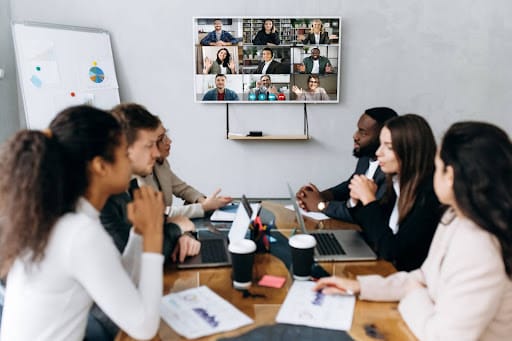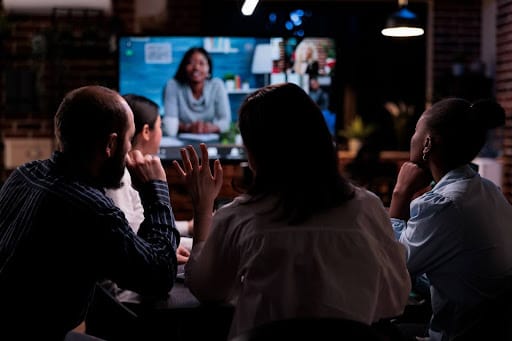The Impact of Mixed Reality on Remote Collaboration and Communication
In businesses worldwide, remote collaboration has become a new normal after pandemic, especially in the era of hybrid work and global teams. The need to bridge physical distances while maintaining productivity, innovation and engagement has driven organizations to explore advanced technologies. Mixed Reality (MR) emerges as a revolutionizing tool that redefines how teams interact, share information and work together virtually.

It seamlessly blends both the physical and digital worlds. MR offers immersive environments where team members can visualize, interact, and collaborate, irrespective of their location. It goes beyond traditional video conferencing or screen sharing, creating shared experiences that feel closer to in-person interactions.
This article explores how Mixed Reality impacts remote collaboration, provides actionable insights, and highlights Flam’s advancements in the MR space.
MR Revolutionizing Collaboration with Shared Virtual Spaces
Mixed Reality introduces shared virtual spaces where teams can connect and collaborate dynamically. These environments allow participants to engage with 3D content, interact in real-time, and create solutions together, much like they would in a physical workspace.
Some of the key features of Mixed Reality in Collaboration are as follows:
Feature | Description |
Spatial Awareness | Enables participants to perceive digital objects in 3D, fostering better understanding. |
Real-Time Interaction | Teams can work on the same project simultaneously, with updates visible instantly. |
Persistence | Virtual workspaces can remain intact, allowing teams to pick up from where they left off. |
Device Agnosticism | Mixed Reality environments can be accessed via smartphones just by scanning a QR code. |
These features create a deeper sense of presence, helping teams overcome the limitations of remote setups. For industries like architecture, engineering, and creative design, Mixed Reality becomes indispensable for project planning and execution.
Enhancing Communication Dynamics with Mixed Reality Immersive Tools
Communication is the key of collaboration, and Mixed Reality revolutionizes how ideas and concepts can be shared. Instead of static presentations or 2D images, MR allows for dynamic storytelling, where participants can interact with data, explore 3D models and visualize outcomes in real-time.
Some of the applications of Mixed Reality in Communication are mentioned below:
Scenario | Impact of Mixed Reality |
Creative Team Discussions | Teams can visualize and manipulate prototypes, layouts, or concepts collaboratively. |
Cross-Departmental Meetings | Mixed Reality bridges understanding gaps with shared visualizations and simulations. |
Training and Onboarding | MR provides immersive scenarios that make learning faster and more intuitive. |
Global Client Presentations | Presenters can showcase products or ideas in an interactive way, capturing audience attention. |
This ability to enhance communication leads to stronger connections, clearer decision-making, and more productive outcomes.
Mixed Reality Redefining Team Engagement and Productivity
Mixed Reality creates collaborative environments that encourage active participation and innovation. Some of the factors influencing engagement are tabulated below:
Aspect | How Mixed Reality Contributes |
Shared Experiences | Virtual team-building activities and brainstorming sessions bring teams closer. |
Emotional Connection | 3D avatars and spatial audio replicate in-person conversations, building rapport. |
Task Involvement | Interactive problem-solving tasks enhance focus and creativity. |
With Mixed Reality, employees feel a stronger connection to their team and the tasks at hand, leading to improved satisfaction and output.
Addressing Remote Work Challenges with Mixed Reality
Remote work comes with its own set of challenges such as disengagement, miscommunication, and lack of real-time feedback being some of the most common. Mixed Reality offers solutions that tackle these head-on.
Challenge | Mixed Reality Solution |
Lack of Engagement | Interactive elements keep participants involved throughout the collaboration process. |
Limited Feedback Mechanisms | MR enables real-time interactions, feedback loops, and adjustments during collaborative sessions. |
Isolation Among Teams | Virtual proximity fosters a sense of connection and teamwork, even in remote setups. |
By addressing these issues, Mixed Reality not only makes remote collaboration possible but also enhances it beyond traditional office interactions
Insights for Future Adoption of Mixed Reality
Currently, Mixed Reality is making strides by transforming remote collaboration, its future holds even greater potential. Organizations looking to adopt MR should focus on creating sustainable strategies to integrate it into their workflows. Some of the key considerations for businesses are mentioned below:

Ease of Integration
MR tools should seamlessly integrate with existing communication platforms and workflows.
Training and Onboarding
Teams must be familiarized with MR tools to ensure smooth adoption and effective utilization.
Content Personalization
Virtual spaces and assets should be tailored to the organization’s specific goals and requirements.
Data Security
As MR environments involve sensitive data, robust security measures must be in place.
A thoughtful approach to adoption will allow businesses to maximize the benefits of MR, ensuring long-term success and growth.
Flam’s Pioneering Role in Mixed Reality Innovation
Flam has consistently positioned itself as a leader in Mixed Reality, making waves across industries with its innovative solutions. While its primary focus lies in marketing and advertising, Flam’s advancements have direct implications for remote collaboration and communication.
Flam's platform allows brands to create shareable MR experiences, driving engagement across devices.
Designed for billions of users, Flam’s technology ensures smooth functionality without the need for app downloads.
Final Thoughts
Mixed Reality, a latest technological breakthrough redefines how remote teams collaborate and communicate. By creating immersive, engaging environments, MR addresses the gaps of traditional remote setups, making teamwork more intuitive and effective.
As organizations continue to embrace hybrid models, investing in Mixed Reality will not only enhance collaboration but also future-proof operations for an increasingly digital world. Flam’s innovations in MR provide a glimpse into what’s possible, making it an exciting time for businesses ready to explore this transformative technology.